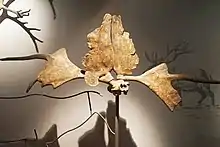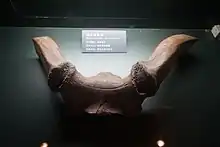中華大角鹿屬
中華大角鹿屬(學名:Sinomegaceros),又名腫骨鹿、中國大角鹿,是一屬已滅絕的鹿科動物,生存於早更新世至晚更新世的中亞和東亞,被認為是"巨型鹿群體"(通常稱做Megacerini)的成員,可能是大角鹿屬的亞屬。該屬以獨特的掌狀鹿角而聞名。
| 中華大角鹿屬 化石时期: | |
|---|---|
 | |
| 矢部中華大角鹿(Sinomegaceros yabei),於国立科学博物馆展出 | |
 | |
| 腫骨鹿(Sinomegaceros pachyosteus),於大庆博物馆展出 | |
| 科学分类 | |
| 界: | 动物界 Animalia |
| 门: | 脊索动物门 Chordata |
| 纲: | 哺乳纲 Mammalia |
| 目: | 偶蹄目 Artiodactyla |
| 科: | 鹿科 Cervidae |
| 亚科: | 鹿亞科 Cervinae |
| 族: | 鹿族 Cervini |
| 属: | †中華大角鹿屬 Sinomegaceros Dietrich, 1933 |
| 种 | |
| |
| 異名 | |
| |
分類學


1932 年中國古生物學家楊鍾健根據來自周口店的化石材料命名了被歸類為鹿屬的腫骨鹿和河套大角鹿。[2] 德國古生物學家威廉·奧托·迪特里希在次年的一篇論文評論中建立中華大角鹿亞屬作為鹿屬的亞屬,並使用腫骨鹿當作模式種[3] 由於該名稱沒有在正式的研究論文中發表,因此在發表後的幾十年裡並未得到廣泛使用,[4]矢部中華大角鹿在1938年被命名。[5]
在接下來的幾十年裡,各研究人員認為牠是大角鹿屬的亞屬,[6][7]或者是有效的屬。[8][9] 一些已建立的種可能是異名。[4]
最著名的物種是生存於日本的中更新世至晚更新世的矢部中華大角鹿(學名:S. yabei),與生存於中國的早更新世晚期至晚更新世的腫骨鹿(學名:S. pachyosteus) 。
演化
目前發現最古老的物種是發現於中國麗水層下部的公王嶺大角鹿(S. konwanlinensis),出現在110至115萬年前。 腫骨鹿(S. pachyosteus) 約在100萬年前出現。已知最年輕的物種是發現於鄂尔多斯市的河套大角鹿(S. ordosianus),出現在3.5至5萬年前。矢部中華大角鹿(S. yabei)則最早出現在日本的中更新世後半期。[11] 矢部中華大角鹿(S. yabei)和腫骨鹿(S. pachyosteus)可能源自公王嶺大角鹿(S. konwanlinensis)。[4]雖然中華大角鹿被認為在12000年前滅絕,但由於缺乏精準的放射性碳定年法,因此不確定中華大角鹿的準確滅絕時間。 [12]
參考
- Vislobokova, I. A. . Paleontological Journal. 2013, 47 (8): 833–950. ISSN 0031-0301. S2CID 86697746. doi:10.1134/S0031030113080017 (英语).
- Young, C.C., 1932. On the Artiodactyla from the Sinanthropus site at Chouk’outien. Palaeontogia Sinica, Series C 8 (2), 159
- Dietrich, W.O., 1933. [Review of] C.C. Young: on the Artiodactyla from the Sinanthropus Site at Choukoutien. Neuest Jahrbuch fu ̈r Miner-alogie, Geologie und Pala ̈ontologie. Referate, III 1933(2), 475–477.
- van der Made, J.; Tong, H.W. (PDF). Quaternary International. March 2008, 179 (1): 135–162 [2023-03-31]. Bibcode:2008QuInt.179..135V. doi:10.1016/j.quaint.2007.08.017. (原始内容存档 (PDF)于2023-03-28) (英语).
- Shikama, T., 1938. Discovery of giant fallow deer from the Pleistocene in Japan. Japanese Journal of Geology and Geography 16 (1–2), 115–122
- Kahlke, H.D., Hu, C.-k., 1957. On the distribution of Megaceros in China (页面存档备份,存于). Vertebrata PalAsiatica 1 (4), 273–283 pl. 1.
- Kahlke, R.D., 1999. The history of the origin, evolution and dispersal of the Late Pleistocene Mammuthus-Coelodonta faunal complex in Eurasia (large mammals). Mammoth site of Hot Springs, SD, inc., 219.
- Shikama, T., Tsugawa, S., 1962. Megacerid remains from Gunma Prefecture, Japan. Bulletin of the National Science Museum 6 (1), 1–13.
- Otsuka, H., Shikama, T., 1977. Studies on fossil deer of the Takao Collection (Pleistocene deer fauna in the Seto Inland Sea, West Japan— Part 1). Bulletin of the National Science Museum 3 (1), 9–40 pls. 1-6.
- Finite element analysis of the hemimandible of the giant deer, Sinomegaceros pachyosteus, revealing its feeding potentialities
- Vislobokova, I. A. . Paleontological Journal. December 2012, 46 (7): 643–775. ISSN 0031-0301. S2CID 85385952. doi:10.1134/S0031030112070027 (英语).
- Iwase, Akira; Hashizume, Jun; Izuho, Masami; Takahashi, Keiichi; Sato, Hiroyuki. . Quaternary International. March 2012, 255: 114–124. Bibcode:2012QuInt.255..114I. doi:10.1016/j.quaint.2011.03.029 (英语).
- Kondo, Y.; Takeshita, Y.; Watanabe, T.; Seki, M.; Nojiri-ko Excavation Research Group. . Quaternary International. April 2018, 471: 385–395 [2023-03-31]. Bibcode:2018QuInt.471..385K. doi:10.1016/j.quaint.2017.12.012. (原始内容存档于2022-06-15) (英语).